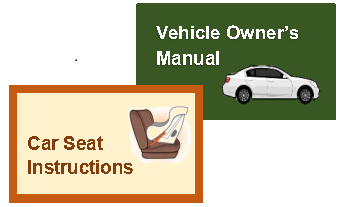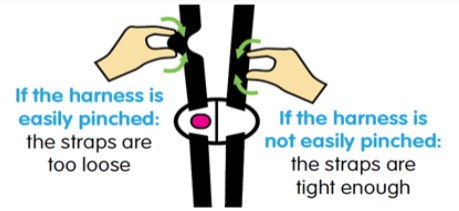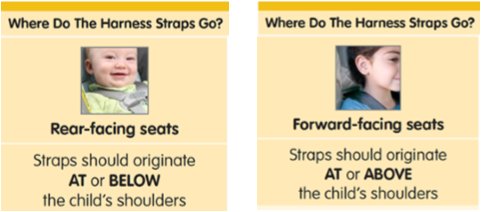Keep Everyone Safe in the Vehicle – Safe Families Always Buckle Up
It’s important that the driver and all passengers are correctly buckled up when traveling. Here are some tips to make sure everyone is properly secured…Every Trip, Every Time.

- Be a good role model: Parents who wear their seat belt are important role models for a child learning good habits in and around vehicles. Research shows that children are more likely to be buckled when the driver is buckled. That is why it is important, not only for a parent’s safety but for their children, that adults always wear their seat belt before putting the car into drive.
- Make sure you always wear your seat belt. Everyone in the vehicle must be properly secured, either by a seat belt, a car seat or booster seat with a lap and shoulder belt.
- Read both the car seat instructions and the vehicle owner’s manual before installing a car seat. Always check the weight and height limits of a car seat.
STEPS FOR CORRECT CAR SEAT USE
| Selection | Select the car seat, booster seat, or seat belt based on the child’s age, weight, height, and developmental level. The car seat or booster seat must fit in the car and be used correctly every time. |
| Direction | Position the child rear-facing to the highest weight or height allowed by the car seat manufacturer. Pennsylvania law requires children to remain rear-facing until two years of age. |
| Location | Place the child in a vehicle back seat position that allows for correct use following the car seat manufacturer’s instructions and the vehicle owner’s manual. |
| Harness Adjustment and Fit | Secure the child with a snug harness. – Rear-facing: AT OR BELOW the child’s shoulders. – Forward-facing: AT OR ABOVE the child’s shoulders. |
| Installation | Install the car seat / booster seat correctly using the vehicle seat belt or Lower Anchors and Tether for CHildren (LATCH). |
Selection: Choose the Right Car Seat
- Always read the car seat instructions and the vehicle owner’s manual. Don’t forget to register the car seat to be notified of recalls.
- Always check the minimum and maximum weight allowed for a car seat. Select a car seat that is correct for the child’s weight and height.
- Select a car seat, belt-positioning booster seat, or seat belt that is in good condition (not been involved a crash, not expired or recalled, no labels missing) and appropriate for the child.
- Always follow the car seat manufacturer’s instructions for guidelines on when the car seat or booster seat must be replaced.
- Rear-Facing: Select a car seat that allows the child’s head to be at least one-inch (1”) from the top of the back of the car seat.
- Forward-Facing: Select a car seat where the mid-point of the head or the top of the ears are not above the top of the shell of the car seat.
- Belt–Positioning Booster Seat: Select a booster seat that positions the vehicle’s lap belt low and snug of the hips/upper thighs and the shoulder belt across the center of the child’s shoulder and chest.
- Seat Belt: Select a lap and shoulder belt when the child is:
- Tall enough to sit on the vehicle seat without slouching.
- Able to keep their back against the vehicle seat back.
- Able to sit with their knees naturally bent over the front edge of the vehicle seat.
- Able to keep their feet flat on the floor.

Direction: For the best possible protection, secure children in a rear-facing car seat until the maximum weight or height allowed by the manufacturer of the car seat.
- Rear-Facing
- In Pennsylvania, always secure children younger than 2 years of age in a rear-facing car seat.
- The child should remain in a rear-facing car seat to the highest weight or height allowed by the manufacturer’s instructions.
- If a child outgrows a rear-facing only car seat before age 2, use a rear-facing convertible car seat to the highest weight or height allowed by the manufacturer.
- Children younger than 2 years are better protected by riding rear-facing to the limits of their convertible car seat.
- The shell of the car seat absorbs the forces of the crash across the entire head, neck and back.
- Forward-Facing
- When children outgrow a rear-facing car seat, secure them in a forward-facing car seat with a harness for as long as possible, up to the highest weight or height allowed by the manufacturer of the car seat.
- The harness absorbs the forces of a crash and holds the child in the vehicle.
- When children outgrow a rear-facing car seat, secure them in a forward-facing car seat with a harness for as long as possible, up to the highest weight or height allowed by the manufacturer of the car seat.
Location: All children younger than age 13 should ride in a back seat.
- Securing children in the front seat:
- Never place a rear-facing car seat in the front vehicle seat if the passenger-side front air bag is turned on;
- If it is necessary to secure a child in a forward-facing car seat in the front seat with an active passenger-side front seat air bag.
- Turn the air bag off or move the vehicle seat back as far as possible, away from the air bag.
- Read and follow car seat manufacturer’s instructions and the vehicle owner’s manual to determine the effect of side-impact air bags.
Harness Adjustment and Fit: Always read and follow the car seat instructions.
- Secure the child properly in the car seat, booster seat, or seat belt. Correct harness adjustment and fit or seat belt fit ensures the child is securely positioned and able to take advantage of the crash protection that the harness or seat belt provides.
- Harness straps are snugly secured to hold the child in the car seat during a crash.
- “A snug strap should not allow any slack. It lies in a relatively straight line without sagging. It does not press on the child’s flesh or push the child’s body into an unnatural position.”
- Harness retainer clip is positioned at armpit level.
How Tight Should the Harness Be?

- The harness should pass the ‘pinch test’; when pinching the harness webbing vertically at the shoulder with the thumb and forefinger, your fingers should slide off easily and you should not be able to pinch any webbing between them.
- The harness should lie flat and fit snugly (not uncomfortable) at the child’s shoulders and hips.
Snug Harness
- Place the child all the way back in the car seat so there is no gap between the back of the car seat and the child’s back.
- Place the harness straps in the correct harness slots for the child as directed by the car seat manufacturer’s instructions.
- Rear-Facing: Place the harness through the correct harness slots AT or BELOW the child’s shoulders following the car seat manufacturer’s instructions.
- Forward-Facing: Place the harness through the correct reinforced harness slots AT or ABOVE the child’s shoulders following the car seat manufacturer’s instructions.
- Buckle and secure the child with a snug harness. A snug harness does not permit excess webbing to be pinched at the shoulder or hips once the harness is buckled.
- Place the harness retainer clip at armpit level.

Correct seat belt fit, for children in boosters or in a seat belt is very important.
- Child is seated all the way back in the booster seat or on the vehicle seat so there is no gap between the seat and the child’s back.
- Position the lap belt portion of the seat belt so it lays correctly across the hips touching the upper thighs.
- Position the shoulder belt across the center of the chest and shoulder.
- Adjust the height of the booster seat or the vehicle head restraint to provide support for the child’s head.
- Installation: Always read and follow the car seat instructions and vehicle owner’s manual.
Installation: Seat Belt/LATCH
- Car seat should be secured with the vehicle seat belt or lower anchor connector routed through the correct belt path.
- Seat belt/lower anchor connector is tight and locked in place allowing no more than 1-inch of side-to-side movement when pulled at the belt path.
- The installation should be checked for tightness each time the car seat is used.
- Always use the tether when installing a car seat forward-facing with the seat belt or lower anchors.
General Method to Obtain a Tight Installation
- Place the car seat on the vehicle seat in the correct direction.
- Thread and tighten the seat belt or lower anchor connectors through the correct belt path.
- Buckle and lock the seat belt or attach the connectors to the lower anchors in the vehicle. Tighten to ensure the car seat does not move more than one-inch when checked at the belt path.
- Attach and tighten the tether with the seat belt or lower anchor connectors on a forward-facing car seat.
